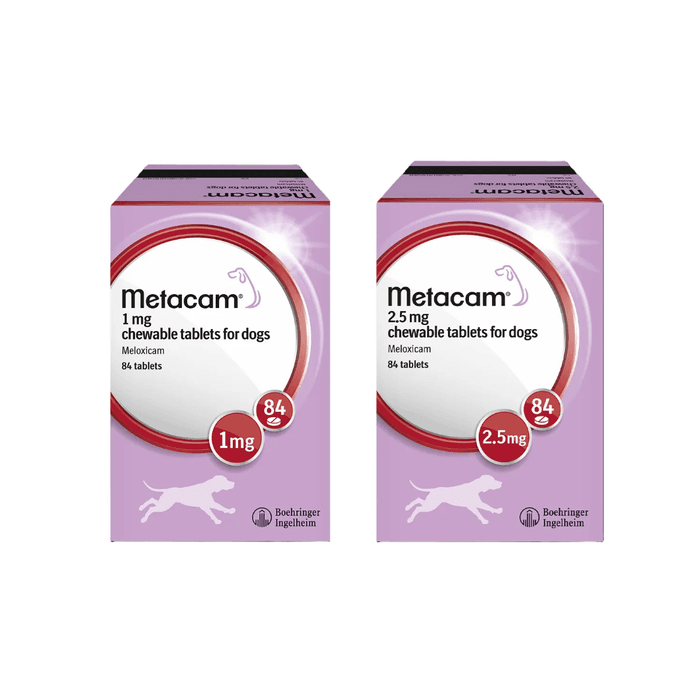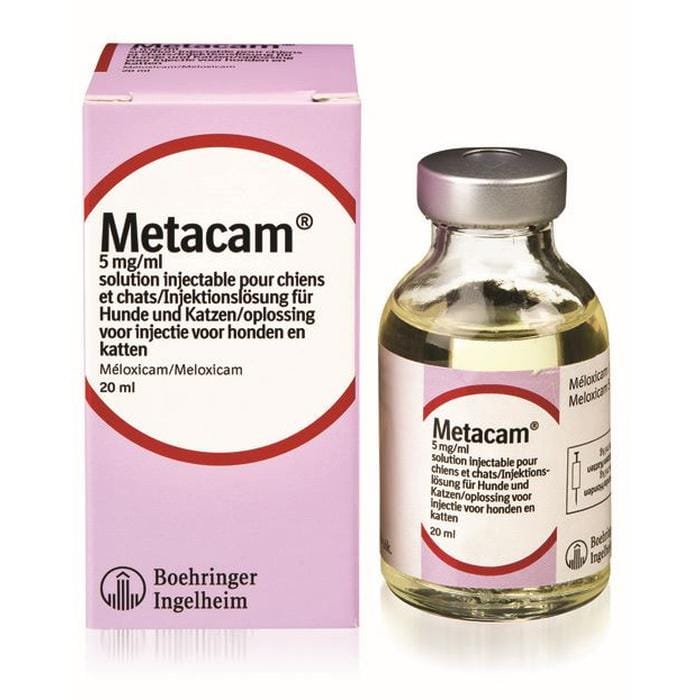Please note: a valid prescription is required for all prescription medication.
Metacam® Oral Suspension for Dogs
Sitewide Super Sale - Get 15% off when you buy 3 or more of the same product using the code LESS15 at checkout.
Applies to all products originating from Canada. Maximum quantity limited to a 90-day supply per order.
Price range: $107.99 through $187.99
You save


Metacam® is a veterinary anti-inflammatory used to relieve osteoarthritis pain in companion animals. This page explains uses, forms, and safe handling, with US shipping from Canada. You can also review options if paying without insurance.
What Metacam Is and How It Works
Metacam® contains meloxicam, a nonsteroidal anti-inflammatory drug (NSAID). It helps reduce prostaglandin production, which can lessen inflammation, joint pain, and stiffness associated with canine osteoarthritis. This medicine is commonly used as part of a long-term management plan for mobility and comfort under veterinary supervision.
CanadianInsulin.com is a prescription referral platform. We verify prescriptions with your prescriber when required, and licensed Canadian pharmacies dispense your order.
You can browse related options within our Pet Medications section for additional context and products.
Who It’s For
This treatment is intended for dogs diagnosed with osteoarthritis or other conditions where an NSAID is appropriate. Your veterinarian may suggest it to reduce pain and improve activity. The cat formulation exists in some markets under veterinary direction; dosing and duration differ from canine use.
Do not use in pets with known NSAID hypersensitivity, active gastrointestinal ulceration, significant kidney or liver disease, or bleeding disorders. Use caution in very young, geriatric, dehydrated, or hypotensive animals. If your veterinarian prescribes it, you can buy metacam online for dogs after dose and form are confirmed. For canine joint care education, see Canine Osteoarthritis. For multi-species context, review Arthritis in Pets.
Dosage and Usage
Use exactly as directed by your veterinarian and per the product label. Dosing is weight-based and measured using the supplied oral dosing syringe. Shake the bottle well before each dose to ensure uniform suspension. Your vet may recommend giving with food to reduce stomach upset. Never combine with another NSAID or a corticosteroid unless your vet specifically instructs it.
Carefully align the syringe scale to your dog’s current weight. Recheck the dose after weight changes, as over- or under-dosing can occur if the syringe is set to an outdated weight. If your vet changes the plan, follow those directions and discontinue any other pain medicines that may interact. If signs of intolerance arise, contact your veterinarian before the next dose.
Strengths and Forms
Availability can vary by region and pharmacy. Common presentations include oral liquid suspension for dogs and a solution for injection used by veterinarians. Cat-labeled suspension exists in some markets; consult your veterinarian for species-specific guidance.
- Oral suspension for dogs, typically supplied with a weight-marked dosing syringe
- Species-specific suspension for cats in some regions; follow veterinary directions
- Solution for injection administered by a veterinarian
For canine therapy, you can find the dog-labeled oral liquid in multiple volumes. If a liquid is not suitable for your pet, discuss alternatives with your vet. To confirm availability of formats, see the product-specific pages for Metacam® Oral Suspension for Dogs and the veterinary Solution for Injection. Some markets also offer a cat-specific oral suspension; ask your veterinarian before using any feline product.
Missed Dose and Timing
If you miss a dose, give it when remembered unless it is close to the next scheduled time. Do not double up. Resume the regular schedule and monitor your pet for any changes. If several doses are missed or your pet shows worsening symptoms, contact the prescribing veterinarian for guidance.
Storage and Travel Basics
Store the suspension at room temperature per the label. Keep the cap tightly closed and protect the bottle from freezing or excessive heat. Do not use if the suspension looks unusually separated after shaking, discolored, or if the seal is compromised.
For travel, carry the original labeled container and a copy of your pet’s prescription. Pack medicines in your hand luggage and avoid leaving them in hot cars. Keep out of reach of children and other animals. If you travel across borders with your pet, carry your veterinary records and plan for refills as directed.
Benefits
This medicine can reduce osteoarthritis pain, support mobility, and improve day-to-day comfort. The oral liquid allows weight-based dosing with a marked syringe. Many veterinarians prefer NSAIDs as a foundational part of multimodal pain management, alongside weight control, controlled exercise, and joint-supportive strategies.
Side Effects and Safety
- Digestive effects: vomiting, soft stool, diarrhea, reduced appetite
- Behavioral changes: lethargy or decreased activity
- Other observations: increased thirst or urination in some animals
Serious but less common risks include gastrointestinal ulceration or bleeding, kidney injury, and liver enzyme elevations. Stop the medicine and contact your veterinarian immediately if you notice black tarry stool, blood in vomit, yellowing of gums or eyes, severe lethargy, or collapse. Animals with dehydration or preexisting organ disease may face higher risk. Cats may require special caution and shorter duration; follow a veterinarian’s specific guidance for any feline product.
Drug Interactions and Cautions
Do not combine this NSAID with other NSAIDs or corticosteroids unless your veterinarian instructs you. Use caution with anticoagulants, ACE inhibitors, diuretics, and other nephrotoxic agents. Tell your veterinarian about all medicines, supplements, and special diets your pet receives, including over-the-counter products.
What to Expect Over Time
Your dog may show improved comfort and mobility when the regimen is followed consistently. Some pets respond gradually as inflammation is managed. Ongoing monitoring helps ensure the benefits continue to outweigh risks. Periodic check-ins, including bloodwork for long-term NSAID use, may be recommended by your veterinarian.
Compare With Alternatives
Other veterinary NSAIDs may be suitable if your pet cannot tolerate meloxicam or needs a different option. Carprofen, such as Rimadyl, is widely prescribed for canine osteoarthritis. Firocoxib (Previcox) and deracoxib (Deramaxx) are additional options; your veterinarian will advise on class, dose form, and monitoring for your dog’s specific situation. For feline pain management discussions, see Onsior for Cats for condition context.
Pricing and Access
We list metacam price clearly on each product page so you can compare bottle sizes and forms. Transparent information helps you plan care and discuss budget with your veterinary team. We also show metacam price without insurance so you can evaluate options when paying out of pocket. Ships from Canada to US is available for most items after your prescription is verified.
Check current bottle sizes and form-specific pricing on the product pages, then place your request. Our checkout is encrypted to protect your information. If you’re looking for seasonal deals, visit our Promotions page for current offers when available.
Availability and Substitutions
Stock can vary by form and bottle size. If a product is unavailable, your veterinarian may suggest an alternative NSAID or a different presentation. You may also see metacam for sale in various package sizes; select the size that matches your vet’s directions. Do not switch between dog and cat formulations without veterinary guidance.
Patient Suitability and Cost-Saving Tips
This treatment may suit dogs with diagnosed osteoarthritis who are good candidates for NSAID therapy. It may not suit pets with active ulcers, uncontrolled kidney or liver disease, bleeding issues, or known meloxicam allergy. Always discuss your pet’s full history before starting any NSAID.
To manage costs, consider multi-month refills if your vet anticipates ongoing use, as larger bottles can reduce your per-milliliter price. Set reminders for timely reorders to avoid lapses. If you prefer a single source, our metacam online pharmacy listing shows bottle sizes and form details so you can align orders with veterinary follow-ups.
Questions to Ask Your Clinician
- Is an NSAID appropriate for my dog’s condition and history?
- Which form and bottle size best fit my dog’s weight and dosing plan?
- What signs of intolerance should I watch for at home?
- How often should we recheck labs during long-term use?
- Can I give other pain medicines or supplements with this treatment?
- What lifestyle changes can support my dog’s joint health?
Authoritative Sources
See the manufacturer’s product information for official indications and safety details on the Metacam site by Boehringer Ingelheim. For approved animal drug listings, review the FDA database at Animal Drugs @ FDA search portal. Health Canada maintains product information; see the Drug Product Database for veterinary entries where available.
Ready to request your pet’s medicine? Place your order with prompt, express shipping with temperature-controlled handling when required. Medical disclaimer: This content is for informational purposes only and is not a substitute for professional medical advice.
Express Shipping - from $25.00
Shipping with this method takes 3-5 days
Prices:
- Dry-Packed Products $25.00
- Cold-Packed Products $35.00
Standard Shipping - $15.00
Shipping with this method takes 5-10 days
Prices:
- Dry-Packed Products $15.00
- Not available for Cold-Packed products
What is Metacam used for in dogs?
It is a meloxicam-based NSAID used to reduce pain and inflammation from conditions like osteoarthritis under veterinary supervision.
Can cats take Metacam?
Cat-specific formulations exist in some markets, but dosing and duration differ and require veterinary direction. Never give dog-labeled products to cats without guidance.
How do I measure the oral suspension dose?
Use the supplied weight-marked syringe. Shake the bottle well, align to your pet’s current weight, and follow your veterinarian’s instructions.
What are common side effects?
Vomiting, diarrhea, reduced appetite, and lethargy can occur. Stop use and contact your veterinarian if severe signs or bloody stool appear.
Can I give this with other pain medicines?
Avoid combining with other NSAIDs or corticosteroids unless your veterinarian instructs it. Discuss all medicines and supplements your pet receives.
Do I need a prescription to order?
Yes. A valid prescription from your veterinarian is required, and we verify it when required before dispensing.
How should I store the suspension?
Store at room temperature per the label. Keep the cap tightly closed, protect from excessive heat or freezing, and keep away from children and other animals.
Rewards Program
Earn points on birthdays, product orders, reviews, friend referrals, and more! Enjoy your medication at unparalleled discounts while reaping rewards for every step you take with us.
You can read more about rewards here.
POINT VALUE
How to earn points
- 1Create an account and start earning.
- 2Earn points every time you shop or perform certain actions.
- 3Redeem points for exclusive discounts.
You Might Also Like
Related Articles
Zepbound storage: Keep It Safe With Clear Temperature Rules
This guide explains Zepbound storage so your medication stays effective. You will learn temperature limits, how long doses can stay unrefrigerated, travel practices, and what to do if a pen…
Zepbound and Fatigue: Practical Tips to Ease Tiredness Safely
Feeling drained after starting tirzepatide can be unsettling. Many users describe a mix of low energy, mild aches, and disrupted sleep early on. If you are navigating Zepbound and fatigue,…
Mounjaro Heart Benefits Beyond Weight Loss: Evidence-Based Guide
Interest has grown around Mounjaro heart benefits as clinicians evaluate tirzepatide’s broader impact beyond glucose control and weight. Patients want clear, cautious guidance. This overview explains what current data suggests,…
Ozempic Rebound: A Practical Guide to Prevent Weight Regain
Many people stop GLP-1 therapy and wonder what comes next. Appetite changes, routine shifts, and metabolism can collide. A clear plan helps you keep progress steady and predictable, not reactive.…


